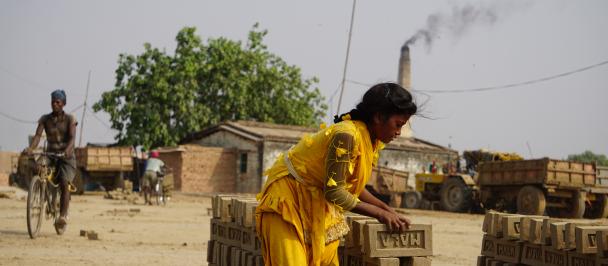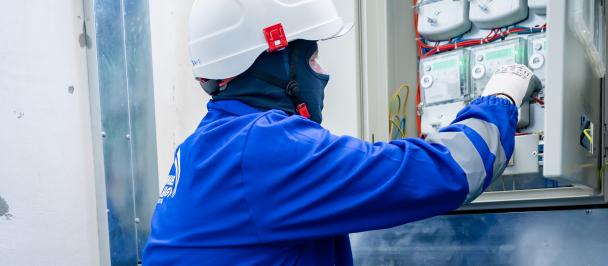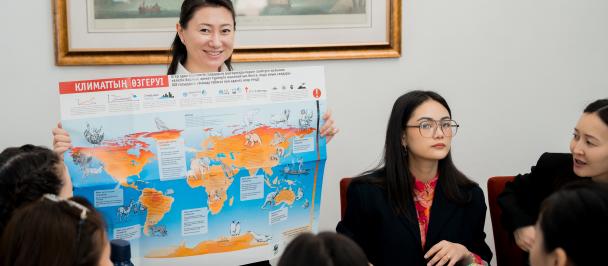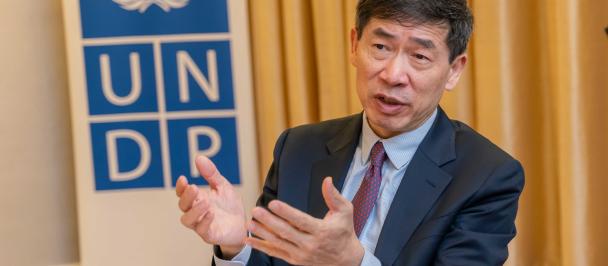By Ms. Caitlin Wiesen, UNDP Viet Nam Resident Representative
Keynote Adress at the conference to kick off the National Action Plan on Circular Economy
June 28, 2022
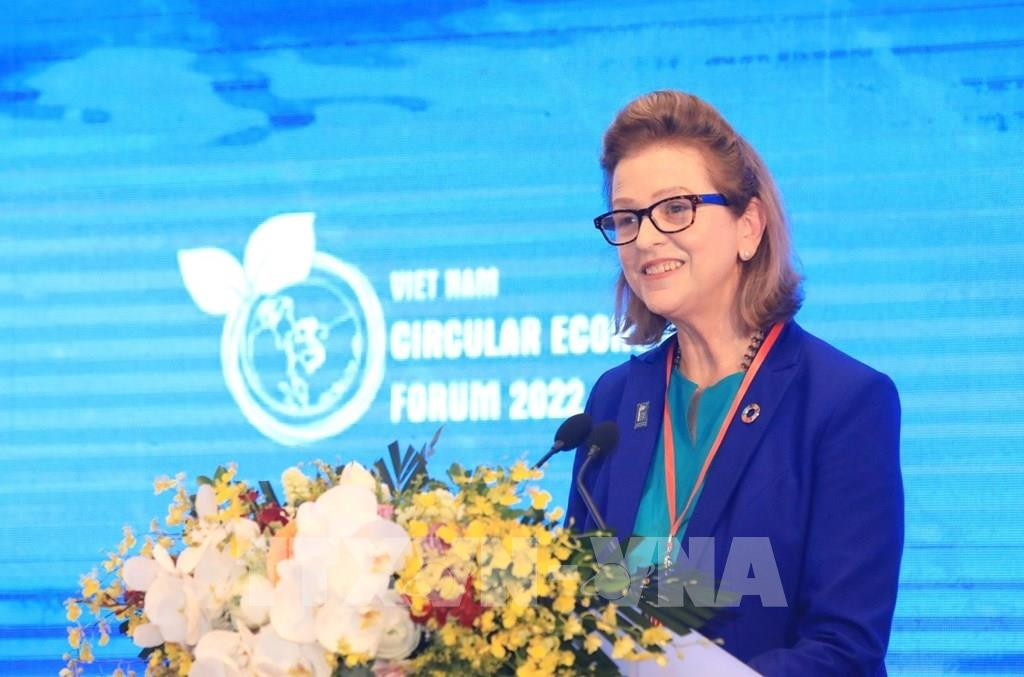
Excellency, Mr. Tran Hong Ha, Minister of Natural Resources and Environment
Mr. Nguyen Duy Hung, Vice Chairman of the Central Economic Commission
Excellencies, distinguished guests,
Ladies and Gentlemen,
Good morning
I am honoured to be here with you to deliver a keynote address at today’s conference, "Opportunities to explore the potentials of circular economy to promote net-zero emission.”
At the outset, I would like to congratulate the Prime Minister Pham Minh Chinh and the Government of Viet Nam for setting clear dual growth goals of becoming a high-income country by 2045 and meeting carbon neutrality by 2050. With this commitment, Viet Nam has joined one of 70 countries that have taken pledges to tackle one of the most pressing issues of our time as we have heard from Minister Ha.
At the COP26, Prime Minister Pham Minh Chinh highlighted the need of “transitioning the development model towards a green, circular, sustainable, inclusive, and humanistic economy. All that we do must be nature-based and centered around people, for they are the actors and drivers of sustainable development, in order to leave no one behind.”
The net-zero commitment made at COP26 in Glasgow and the ongoing revision of the draft National Climate Change Strategy and the draft Power Development Plan No.8 to align with Net Zero Emissions by 2050, taken together with the integration of circular economy into the 10-year Socio-economic development strategy 2021-2030 and the 5-year socio-economic development plan 2021-2025, combine to mark a major cornerstone in Viet Nam’s sustainable energy transition with circular economy at its center.
The triple planetary crisis we are facing today: climate emergency, environmental pollution, and biodiversity loss have the same root causes: our reliance on fossil fuels, our persistent short-term focus of investments, and our lack of imagination.
Medium and long-term strategies should be matched with investment strategies with the same time horizon. At the same time there is an urgent call to change and take action today. Now, more than ever, we need an inclusive circular economy and a Just Climate Transition that sustains and regenerates the natural capital, upon which the people, communities, and the economy depend.
Colleagues and friends,
What would be this new mission? Is it time for a green Doi Moi
I would like to share some recommendations to consider for driving forward a circular economy for net zero, that may be pertinent to Viet Nam.
1. Framing a new mission: ‘a green economic rebound’
The economic recovery from COVID-19 offers a historic opportunity to pivot to a more sustainable and inclusive development model. A Green Recovery could reduce greenhouse gas emissions up to 25% below the business-as-usual scenario by 2030, increasing the probability of keeping temperature rise below 2 degrees Celsius, in line with the Paris Agreement.
At the beginning of the year, we had the honour of co-hosting a conference on a Green Inclusive Economic Rebound with the Government of Viet Nam. Allow me to quote Joseph E. Stiglitz, Professor of Columbia University and recipient of the Nobel Memorial Prize in Economic Sciences (2001), who emphasised that Covid-19 economic recovery programmes and finance in Viet Nam and other countries should serve a triple purpose, including economic recovery, promoting green and sustainable growth, and addressing inequality and inclusion. Professor Stiglitz highlighted the enormous opportunity that addressing climate change offers for creating a more dynamic and inclusive economy, pointing out that promoting economic recovery and addressing climate change does not necessarily require trade-offs. In fact, a green economic rebound provides enormous opportunities for long-term sustainable growth and generating new decent jobs. He stressed that the green economy is the economy of the future and the sooner Viet Nam makes the shift to green, the less chance Viet Nam will have of being among the countries left behind in the green transition.
It is estimated that Viet Nam will require USD 330-370 billion in investments to achieve net zero emissions by 2050 according to the draft National Climate Change Strategy, with significant large up-front investment. Here, foreign direct investment (FDI) and companies have a critical role to play in providing technologies, human and financial capital. Viet Nam has been and continues to be an attractive destination for FDI, and the country is well placed to attract further investment needed to power a just circular and energy transition. FDI already contributes significantly alongside national investments in renewable energy in Viet Nam, including solar, onshore, and offshore wind power.
UNDP’s latest research found that the GDP generated from the sustainable development of Viet Nam’s marine economy will be 34% higher than the business as usual scenario by 2030 (corresponding to a difference of 23.5 billion USD) should the country adopt “blue and green scenarios”. In addition, the gross national income of marine workers, will be 77,9% higher (or 7,100 USD).
The EU Circular Economy Action Plan adopted in 2015 has mapped 54 actions that were adopted or implemented by 2019. According to Eurostat, jobs related to circular economy activities have increased by 6% between 2012 and 2016 within the EU. The action plan has also encouraged at least 14 Member States, eight regions, and 11 cities to put forward circular economy strategies.
2. Promoting circular cities and provinces, as the engines of energy transition.
With 70 per cent of its population living in coastal areas and low-lying deltas, relocation to cities and within cities is quickly accelerating. Over the last 30 years, Viet Nam's urbanisation rate has doubled to 38% and by 2050 it is estimated that 57% of Vietnamese will be urbanised.
Da Nang is the first city that formulated and adopted a city-level roadmap on Circular Economy, with the promulgation of Decision No. 1102 on approval of ‘Research on development of a circular economy in Da Nang city’. UNDP commends the work of the Provincial People Committee of Da Nang for such remarkable achievements in advancing circular economy and UNDP is proud to have supported these efforts over the last two years.
Yet, for other provinces in Viet Nam, developing a specific CE roadmap is not yet feasible. In such cases, it is important to continue to develop guidance and provide tailored solutions for advancing the circular economy for provinces now in the process of implementing their socio-economic development plan 2021- 2026.
In cities, we also see the crucial role that the green transport sector can play, in particular with the increase of electric vehicles. Decarbonising the transport sector brings opportunities to improve mobility, reduce local air pollution, and improve the quality of life. Moving to electromobility could be one of the great opportunities to support the transition to net-zero emissions while bringing substantial benefits to the economy and the health of society.
3. Promoting sustainable,green, and low carbon production and consumption
An estimated 45% of emissions are related to the way we extract, consume, and waste materials. Therefore circular strategies are critical to achieving net-zero emissions. This is why 27% of Parties to the United Nations Convention on Climate Change (UNFCCC) have included references to circular economy in their Nationally Determined Contributions. We commend Viet Nam for being among these countries.
Greater pressure to engage in climate action has led businesses to adopt more aggressive science-based targets which are compatible with 2050 net-zero objectives. For example, more than 3,000 businesses and financial institutions have incorporated science-based targets (SBTi) to reduce their emissions in line with climate science, meaning firms are more strongly engaged in developing a sustainable supply chain to provide green products and meet consumers’ demands. Additionally, initiatives such as The Race to Zero Campaign, Carbon Disclosure Project (CDP), and EcoVadis have prompted companies to be more transparent about their emissions across the supply chain from the purchase of capital goods to end of-life treatment of sold products.
UNDP has just completed a 4 years project on green chemistry, with the Ministry of Indutry and Trade. The results from two companies who joined the pilots (Plato Company on electroplating in Thai Nguyen province and Nishu Company on paint production in Ha Nam province) together, have saved 1,134,000 giga jules equivalent to 42,000 tonnes of coal, in addition to other key environmental benefits such as, reducing the usage of toxic chemicals and their release into the environment.
In this connection, we recently launched our second training programme “capacity building for business on circular economy”, with the generous financial support from the Netherlands Embassy. The programme aims to deliver knowledge, share best practices, and develop circular business models, targeting Small and Medium Enterprises in Ha Noi, Hue, and Ho Chi Minh City.
4. Accelerating renewable energy to enhance energy and meet net zero emssions
As we know, the cost of renewable energy has never been so low. The prices of renewables have declined by 89% in the last ten years, and solar power is now the cheapest source of electricity. 60% of the new capacity in 2021 was added in Asia, resulting in a total of 1.46 Terawatt (TW) of renewable capacity by 2021 . For the first time, wind and solar generated more than 10% of electricity globally in 2021.
50 countries have now crossed this landmark of generating 10% of their electricity needs from renewable and Viet Nam became one of them in 2021. Viet Nam is endowed with enormous potential for renewable energy growth. Over just five years, Viet Nam scaled-up solar energy capacity from almost nothing in 2017 to more than 16,000 MW in 2022, far exceeding national targets.[7] Viet Nam also has enviable wind power potential, particularly for offshore wind, with more than 3,200 km of coastline. In 2022 and 2023, 20 wind power projects will be installed in Soc Trang alone.[8]
Following initial success with the rapid development of solar energy and inshore wind between 2018-2020, thanks to progressive feed-in tariffs (FiTs), Viet Nam still have a long way to deploy full potential of renewable energy capacity given a number of constraints:
A major constraint on Viet Nam's decarbonisation programme is access to long-term financing. In addition, Viet Nam’s unclear renewable energy policy with respect to FiTs has caused some frustration among investors, and inhibited Viet Nam from realizing the full green FDI potential. For example, new FiTs for solar development have not been issued since the end of 2020 and November 2021 for wind power.
Viet Nam also faces some technical challenges. In 2021, supply redundancy presented a new obstacle as the boom in solar unfolded together with grid congestion. The current transmission grid is of insufficient capacity to cope with the spikes and fluctuations of renewable energy generation from all solar and wind farms.
Furthermore, large investments in storage capacity of renewable energy are needed to store surplus energy. So far, Viet Nam does not have and has not yet invested in energy storage capacity. In this connection, investments in research and development and usage of hydrogen can present Viet Nam with advantages to lead cutting edge technologies.
5. Ensuring that no one is left behind, the transition should also deliver benefits by, and for the people of Viet Nam
The circular economy is not an end in itself; rather, it is a mean to achieving a low carbon transition and delivering on Agenda 2030. Against this backdrop, Chatham House launched during the Stockholm Consultation earlier this month entitled 'A Global Roadmap for Circular Economy’, advocating for a social perspective on CE that has at its core human needs, decent work, good health and demonstrating how the circular transition can contribute to poverty reduction and overall well-being.
Circular economy and climate policies will have implications for the future of jobs. A recent study by UNDP in Indonesia found that 75% of the 4.4 million jobs created by adopting circular opportunities in four sectors will be for women, as sectors traditionally employing more men (extractive industries and construction) will be displaced. This will require investing in educating the new generation of women engineers, architects, scientists, and urban planners, who will create the pathway of the transition and design the future of tomorrow.
Equally, it is critical to ensure that the current trend of formalisation of the waste management sector is not achieved at the expense of the informal sector and, in particular women. Globally, it is estimated that less than 10% of the plastic produced has been recycled. While the share of plastic waste is skyrocketting in Viet Nam, and imports of waste are overwhelming already stretched waste management systems, we at UNDP are piloting an ‘inclusive Material Recovery Facility (MRF)’ in Binh Dinh Province. The intention of the MRF is to establish a secondary market among private sector entities for plastic and waste to foster a signifianct uptake in reuse of materials. The MRF will generate direct and indirect employment for women working across the waste value chains with financial support from the Norwegian Government.
Ladies and gentlemen,
Today, we have the opportunity to mobilise massive technological shifts for the CE transition, not just to do better than yesterday but to spring forward to a new green future. In this respect, I would like to highlight four key enablers to consider for framing the path that will help Viet Nam transition to net zero in less than thirty years.
I would like to underline that the Circular Economy is an economic opportunity for Viet Nam and investing in governance systems, developing strong institutions and policies, fostering sustainable business and bypassing pollutive industries will help Viet Nam rebound to the green economy of the future. We believe that by joining our collective efforts, openly sharing data and knowledge, will help to shift mindsets, and frame and adopt a narrative around a Circular Economy that is tailored to the needs, the history, and the ambitions of the people of Viet Nam.
We are therefore delighted to launch today together with the Ministry of Environment and Natural Resources the Viet Nam Circular Economy Hub. The mission of the CE Hub is anchored around three pillars: enhancing dialogue, generating know-how, and mobilizing collective action towards the circular economy transition.
The Viet Nam Circular Economy Hub aims to raise awareness and build the capacity of all stakeholders, including public authorities, businesses, non-governmental organizations, and academia, in adopting CE principles, creating synergies, and integrating financial and technical resources to support the transition towards a low-carbon and circular Viet Nam. The CE Hub, houses the latest need-to-know science and insights from leading actors and communities in the fields of circular economy CE policy, research, investment and education. There are already more than 185 articles published on the website in Vietnamese, and more than 25 members have joined our network. We truly welcome your insights, contribution, and participation in the CE Hub as it continues to evolve and develop.
Excellences, Ladies and Gentlemen,
We, at UNDP, are deeply committed to supporting the Government of Viet Nam in framing this moonshot vision of a green economic rebound, and a low-carbon and inclusive circular economy to deliver on net-zero emissions by 2050. UNDP calls on all our partners to join together and embrace the mission for an Inclusive Carbon-Neutral Circular Economy – one that, re-shapes value chains, re-thinks consumption and production patterns, and reprioritizes the role of women in the process, to ensure a just transition that ensure that no one is left behind.
In closing, allow me to express our great appreciation for the strong collaboration with the Government of Viet Nam and the Ministry of Natural Resources and Environment in advancing the country's transition towards a green, sustainable, and circular Viet Nam with peace and prosperity for the people and for the planet.
Thank you! Xin cảm ơn!

 Locations
Locations